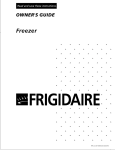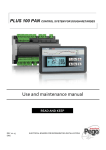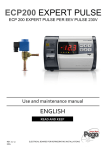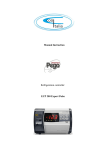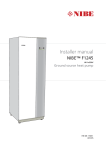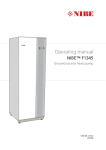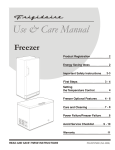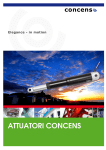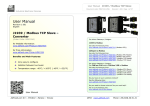Download Draft of Service Manual NDA/NDE 1402
Transcript
Draft of Service Manual NDA/NDE 1402 TECHNICAL DESCRIPTION .............................................................................................................3 GENERAL ..............................................................................................................................................3 SYSTEM PARTS FOR COOLING AND DEFROSTING ...................................................................................4 GAS BURNER ASSEMBLY .......................................................................................................................4 ELECTRICAL SYSTEM ............................................................................................................................4 Type of component ..........................................................................................................................5 POWER MODULE ...................................................................................................................................6 FRONT PANEL DISPLAY MODULE ...........................................................................................................7 GAS CONTROL MODULE ........................................................................................................................8 ELECTRICAL HEATER FOR AC OPERATION OF COOLING UNIT ...............................................................8 DEFROSTING ELEMENTS .......................................................................................................................9 AIR CIRCULATING FANS ........................................................................................................................9 TEMPERATURE SENSORS .......................................................................................................................9 LAMPS FOR INTERIOR LIGHT AND DOOR SWITCHES ...............................................................................9 OVERHEATING PROTECTION FUSE .......................................................................................................10 INTERCONNECTION BOXES AND COMMON CABLE HARNESSES ............................................................10 Interconnection box in freezer ......................................................................................................10 Interconnection box in fridge........................................................................................................10 Connection of the fan in fridge .....................................................................................................10 ANTI-FREEZING SYSTEM FOR ICEMAKER WATER SUPPLY ....................................................................10 FUNCTION DESCRIPTION ..............................................................................................................11 POWER ON/OFF.................................................................................................................................11 SELF-TEST AT POWER ON ....................................................................................................................11 AC SENSING .......................................................................................................................................11 ENERGY SELECTION............................................................................................................................11 SELF-TEST BEFORE GAS IGNITIONS .....................................................................................................11 GAS IGNITION PROCEDURE .................................................................................................................11 GAS LOCK OUT ...................................................................................................................................12 FLAME DETECTION PRINCIPLE ............................................................................................................12 THERMOSTATIC OPERATION ...............................................................................................................12 TEMPERATURE DISPLAY .....................................................................................................................13 REAL TIME CLOCK ..............................................................................................................................13 AUTOMATIC DEFROSTING ...................................................................................................................14 Temperature "pull down"..............................................................................................................14 Cooling unit relax time .................................................................................................................14 Heating in the freezer....................................................................................................................14 Heating in the fridge .....................................................................................................................14 Freezer fan operation during and after a defrosting ....................................................................15 Power breaks during a defrosting.................................................................................................15 Canceling of an automatically initiated defrosting.......................................................................15 MANUAL DEFROSTING ........................................................................................................................15 ERROR MESSAGES...............................................................................................................................15 SERVICE MODE ...................................................................................................................................15 TROUBLE SHOOTING......................................................................................................................16 START UP FAULTS ...............................................................................................................................16 AC/GAS SELECTION FAULTS .............................................................................................................17 TROUBLE SHOOTING BY MEANS OF "SERVICE MODE" .........................................................................18 Test 01: Display test......................................................................................................................18 Test 02: DC power test. ................................................................................................................18 Test 03: Air temperature sensor test. ............................................................................................18 Test 04: Cooling temperature sensor test. ....................................................................................18 Test 05: Door sensor test. .............................................................................................................18 Test 06: 120V AC test. ..................................................................................................................18 Test 07: Test of heating element in fridge.....................................................................................18 Test 08: Test of heating element in freezer. ..................................................................................18 Test 09: Test of heating element in water drain bin and pipes. ....................................................19 1 Draft of Service Manual NDA/NDE 1402 Test 10: Test of heating element in door frames and ice maker waters supply anti-freezing system............................................................................................................................................19 Test 11: Test of fan in the fridge ...................................................................................................19 Test 12: Test of fan in the freezer..................................................................................................19 Test 13: Gas operation test. ..........................................................................................................19 TROUBLE SHOOTING AT "CALL FOR SERVICE" ERROR MESSAGES .......................................................20 "Er 11":.........................................................................................................................................20 "Er 12":.........................................................................................................................................20 "Er 13":.........................................................................................................................................21 "Er 14":.........................................................................................................................................21 "Er 15":.........................................................................................................................................21 "Er 16":.........................................................................................................................................21 "Er 17":.........................................................................................................................................21 "Er 18":.........................................................................................................................................22 "Er 19":.........................................................................................................................................22 2 Draft of Service Manual NDA/NDE 1402 Technical description General The refrigerator has two compartments with separate doors. The left one is a frozen food compartment (the freezer) and the right one is a fresh food compartment (the fridge). Both compartments are operated by a common cooling system, working according to the absorption principle. The cooling system may use either 120 V AC or LP gas as energy source for the cooling. Energy selection is made either automatically or manually (forced to gas). An optional version may only be operated on 120 V AC (AC only version). The refrigerator has automatic defrosting in both compartments. To allow defrosting of the freezer without heating up the frozen food, the freezer is cooled through air that is circulated by means of a fan through a cooling chamber. The air circulation is stopped during defrosting and if door is opened. Also the fridge compartment has a fan that is stopped during defrosting, but still running if door is opened. Defrosting is performed by means of heating elements on the cooling surfaces. Even though there is only one cooling system, the compartments have independent temperature controls. The main thermostat controls the cooling unit to run until temperatures are low enough in both compartments. To prevent the fridge to be too cold, a secondary thermostat is controlling a heat source in the fridge compartment (the same heating element that is used for defrosting). An electronic control system performs the automatic energy source selection, the thermostat function and the defrosting process. Fig. 1 Rear view equipment used for text reference 3 Draft of Service Manual NDA/NDE 1402 System parts for cooling and defrosting The refrigerator has the following main system parts: • Cooling unit • Gas burner assembly • Electrical system • Ice maker Gas burner assembly The gas burner assembly consists of a burner house, an electrically controlled gas valve and an ignition electrode. The gas valve solenoid and the ignition electrode are connected to, and controlled from an electronic gas burner control unit. See electrical system. Fig. 2 Gas burner assembly Electrical system The electrical system consists of the following components: • Main electronic control unit (power module) • Electronic gas burner control unit • Front panel display module • Electrical heater for AC operation of cooling unit • Electrical heater in door frame • Electrical heaters for defrosting in the freezer, fridge and water drain pipe • Fans, one in each compartment • Temperature sensors (two in each compartment) • Lamps and door switches for interior light • Overheating protection fuse • Cabling harnesses • Anti-freezing system for icemaker water supply (optional) 4 Draft of Service Manual NDA/NDE 1402 Fig. 3 Wiring diagram Fuse (from left to right in fig. 3) 3A 7.5 A 3A 7.5 A 5A Type of component A, B, C, E, G, H, P, R S, T W (Optional ice maker kit) X Z Table 1 Components protected by fuses. 5 Draft of Service Manual NDA/NDE 1402 Fig. 4 Ice maker wiring diagram Power module The power module is the main control unit that acts as the heart of the electronic control system. It performs power ON/OFF control, energy selection, thermostatic operation control and defrosting control. All other electrical parts are connected to the power module. Tab connectors from left to right (at the bottom edge of the board): • J1 is the ground connection. • J2 is the 12 V battery voltage input to the power module. • J3 and J4 are connected in parallel and are supplying 12 V to the door frame heater and the anti-freezing system for the ice maker water supply. • J3 is the output to the defrosting element in the freezer • J6 is the AC neutral connection for the ice maker. • J7 is the AC mains cord neutral connection. • J8 is the AC neutral connection for the AC heaters in the cooling unit. • J9 is the AC line connection for the AC heaters in the cooling unit. • J10 is the AC mains cord line connection. 6 Draft of Service Manual NDA/NDE 1402 • J11 is the AC line connection for the ice maker Multipole connectors: • P1 is a 6-pole connector (white housing) at the left edge of the board for the cable to the front panel display module. • P2 is a 4-pole connector (blue housing) at the right end of the board for the temperature sensors in the freezer. • P3 is a 4-pole connector (white housing) at the left top corner of the board for the temperature sensors in the fridge. • P4 is a 10-pole connector at the left end of the board for lamps, door switches and the fan in the fridge. • P5 is a 6-pole connector (blue housing) at the right edge of the board for the fan in the freezer and for the defrosting elements in the fridge and in the water drain. • P6 is a 4-pole connector (red housing) at the top right corner of the board for the gas operation control module. • P7 is a connector for computerized factory testing of the refrigerator. Fuses from left to right: • F2 is a 3 A fuse of Auto Fuse type and is protecting 12 V circuits on the power module itself, the display module, interior lights and the gas operation module. • F6 is a 7.5 A fuse of Auto Fuse type and is protecting the defrosting elements in the fridge and in the water drain. • F3 is a 3 A fuse of Auto Fuse type and is protecting the heating element in the door frame and the anti-freezing system for the ice maker water supply. • F4 is a 7.5A fuse of Auto Fuse type and is protecting the defrosting element in the freezer. • F5 is a 5 A glass type fuse protecting the 120V AC heater in the cooling unit. For details about the function of the power module, see the functional description section. Front panel display module The display module is the user interface and acts just as a slave to the power module. It has three buttons and four seven-segment LED displays. The leftmost button is he ON/OFF button and is directly controlling the power module. It has no direct influence on the processor on board. The button is not actually switching any current, but is just giving a signal on a separate wire down to the power module to switch the system ON or OFF. The button in the middle is the AUTO/STORE button. At normal operation this button is used to toggle energy selection mode between AUTO and MANUAL. This button is, however, also used to store thermostat and clock settings during setting procedures. If this button is held down during power-up, a manually initiated defrosting will start. The rightmost button is the SET button. It is used for thermostat and clock settings. If this button is held down during power-up, service mode will be initiated. For details, see the functional description section. 7 Draft of Service Manual NDA/NDE 1402 Depressions of the AUTO/STORE and SET buttons are interpreted by means of the display board processor, which then sends commands via a serial data bus down to the power module. The power module processor then executes the commands. The seven-segment displays are normally used to show the temperatures in the compartments. However, the temperature display may be interleaved by means of flashing with a number of status or error messages. During setting procedures (thermostat and clock settings) the displays are used to show setting information. The "decimal points" are positioned at the top of the display and these "points" are from left to right used to indicate PM at clock setting, AUTO mode, AC operation and GAS operation. The information displayed is controlled from the power module processor. When fridge door is closed, the display is dark. For setting procedures, see the functional description section. Gas control module The gas control module has the full responsibility for automatic operation of the gas burner. On request from the main control unit (the power module) the gas control module ignites and supervises the flame. It reports back to the power module if gas operation is OK or not. The module is connected to the power module via a 3-wire cable. The wires are +12 V supply to the gas module, a gas request signal and a status signal back to the power module. The fourth pin in the cable connector at the gas control module end has a short cable that is connected directly to ground. The gas valve solenoid is connected to a two-pole connector on the gas control module. The connection polarity at the solenoid is not essential. The ignition electrode is connected to a tab connector on the high voltage transformer on the gas control module. IMPORTANT NOTES: The gas control module has an additional ground strip wire underneath the left mounting tag. This wire must be in good contact with the metal frame of the burner assembly before the system is energized. Otherwise both the gas control module and the power module may be damaged. Never energize the system with the spark electrode disconnected! For details about the function of the gas control module, see the functional description section. Electrical heater for AC operation of cooling unit When operated on 120 V AC, the cooling unit is heated by means of two elements connected in series. The heaters are connected to two tab connectors (J8 and J9) on the power module. Refer to wiring diagram. 8 Draft of Service Manual NDA/NDE 1402 Electrical heater in door frame The refrigerator has a heating element in form of a heating cable at the inside the door frame. This heater will protect against damp or frost on the door frame in high environments with high humidity. The heater is ON as long as the refrigerator is switched ON, except during defrosting. The heating element is operating on 12 V DC. One end of the element is connected to chassis ground near the power module and the other to tab connector J4 on the power module. The wires are foamed in and have no interconnections on the way down to the power module. Defrosting elements Both the freezer and the fridge have heating elements for defrosting. The elements (heating films) are glued to the cooling surfaces. Both these heating films have integrated overheating protection fuses. These fuses should not blow unless there is a severe fault in the control system. If such a fuse is blown, the heating film has to be replaced. Also the water drain system has a defrosting element in form of a heating film glued to the bottom of the drain bin in the freezer. The heating film is also heating a part of the pipe that goes from the freezer to the fridge drainage system. All these defrosting elements are operated on 12 V DC. See "Interconnection boxes and cable harnesses" for connection information. Air circulating fans Both the freezer and the fridge have fans for air circulation. The fans are operating on 12 VDC. The cables are interconnected to common harnesses in in each compartment. See "Interconnection boxes and cable harnesses". Temperature sensors There are four temperature sensors in the refrigerator, two in each cabinet. The sensor cables goes directly down to the power module without any interconnections. At the power module the sensors share connectors, one connector for the fridge and one for the freezer. The connectors have different colors so they will not be interchanged. Refer to power module for connector positions. Lamps for interior light and door switches Both compartments have interior lights controlled by door switches. Both lamps are of halogen type, but note that the lamp in the freezer shall have a power of maximum 5 W, while the lamp in the fridge is a 10 W lamp.. Lamps and switches are directly connected to the power module. The wires are foamed in and end up in the 10 pole Molex MiniFit connector P4. The lamps are directly controlled from the switches and the interconnections are on the board. The processor on the power module can not control the lamps but senses if the switches are closed or not to decide if doors are open or closed. 9 Draft of Service Manual NDA/NDE 1402 Overheating protection fuse The boiler casing on the cooling unit has an overheating protection fuse that breaks the 12 V supply to the power module in case of overheating. Interconnection boxes and common cable harnesses Interconnection box in freezer At the rear wall of the freezer compartment there is an interconnection box where the defrosting element in freezer, the defrosting element in water drain and the fan in the freezer are interconnected to a common cable harness through the rear wall and down to the power module. The freezer defrosting element is connected to a tab connector block. The heater in the drain bin and the fan have each a two pole Molex MiniFit connector. Note that the freezer defrosting element must be connected with the marked wire connected to ground (the black wire) so that the overheating protection fuse will be at the positive side. Note also that the two Molex connectors must be connected correctly. The connectors should be positioned so that wires with white insulation (to heating element in drain) are connected to wires with white and yellow insulation. The fan is connected to wires with red and black insulation. Interchange of the two Molex connectors could damage the power module. At the power module these cables end up in the connector P5 (fan and drain heater) and as separate wires (freezer defrosting element) connected to chassis ground and to tab connector J5. Interconnection box in fridge At the rear wall of the fridge compartment there is an interconnection box where the defrosting element in fridge is interconnected via a 2-pole MiniFit Molex connector to a cable harness that goes trough the rear wall and down to the power module. At the power module these wires end up in the connector P5 Connection of the fan in fridge The fan in the fridge is, via a screw terminal block placed inside the fan housing, connected to foamed in wires that goes down to the power module, connector P4. Note that the wires must be correctly polarized, red wire to red wire. Wrong polarization will not damage anything, but the fan will not run. Anti-freezing system for icemaker water supply The water valve and the water pipe from the valve to the icemaker is protected from freezing by means of a thermostat controlled heating system. This system has a thermostat that switches on a heating cable in the water tube and a heating film on the water valve when temperature becomes so low that there is a risk for freezing. The system is operated from 12 VDC available at tab connector J3 on the power module. 10 Draft of Service Manual NDA/NDE 1402 Function description Power ON/OFF The processor on the power module is always operating as soon as 12 V DC is connected to the refrigerator. The processor decides if the system shall be ON or OFF by means of information stored in a non-volatile memory in the processor. So even if the 12 V disappears for a while, the system will start up in the state it was before the 12 V disappeared. Toggling between ON and OFF occurs on depressions of the ON/OFF button on the front panel. When in OFF state, the processor is in "sleep mode" and the system will draw a current of less than 1 mA from the +12V battery supply. Self-test at power on At power ON the system performs a self-test to check the integrity of the system. Some self-tests are also performed repetitively during normal operation. If a fault is detected, an error message is displayed on the front panel. If the gas control module is not detected at this power ON self test, The system enters the AC only mode (some refrigerator models have no gas operation and should always have 120V AC to operate) . The gas control module performs its own self-test at power on. This test is identical to the self-test performed at every gas ignition request. See further down. AC sensing The incoming 120 V AC is all the time checked for availability by means of an optocoupler. There is a delay of 15 seconds before a change is recognized to avoid spurious switching. When AC is not available in AC only refrigerators, the message "no AC" is shown on the front panel. For refrigerators equipped with gas operation facility, see "Energy selection" below. Energy selection The cooling unit may operate on either 120V AC or LP gas. The selection is either automatic or manual. In the latter case the selection is forced to LP gas operation. At automatic selection, AC will be used if available. If not available, LP gas will be used. AUTO mode is enabled/disabled by means of a button on the front panel. Self-test before gas ignitions At every gas operation request from the power module, the gas control module performs an integrity test of the gas burning system. This test will detect if the system is operable or not. A fault will result in a lock out mode. See further under "Gas lock out" below. Gas ignition procedure At a gas operation request from the power module, first a self-test is made, see above. 11 Draft of Service Manual NDA/NDE 1402 If system is OK, the gas valve is opened and sparks are generated. As soon as the electrode senses that the flame is burning, the sparking stops. However, if the flame later goes out, the sparking starts again. If flame is not ignited within 45 seconds of sparking, the valve is closed again and the ignition is stopped. After a two minutes pause, a new ignition attempt is made. If the flame is not ignited after three such 45 seconds long attempts, the system goes to a lock out mode. See "Gas lock out" below. Gas lock out If the self-test fails or if a gas ignition attempt fails, the gas control module will enter a "lock out mode". This lock out mode is reported back to the power module and the message "ch LP", meaning "check LP gas burner system", will be displayed flashing on the LED displays. The "lock out mode" is only reset by switching the refrigerator OFF and then ON again. Flame detection principle The flame is detected by a method often called "flame rectification sensing". A gas flame is slightly conductive and by applying a voltage to the spark electrode, a small current will flow through the flame to chassis ground. However, the flame conductivity depends on the polarity of the applied voltage. A positive voltage on the electrode will result in a higher current than a negative voltage. This "rectification property" of the flame is used to distinguish it from leakage currents that could depend on dirt or moisture. To detect if a flame is present, a high frequency AC voltage is applied to the spark electrode. The rectification property then causes that the electrode will have a slightly negative DC voltage that is detected by the gas control module. The AC voltage and the resulting negative voltage are not possible to measure with normal methods, as the impedance is too high. Thermostatic operation The refrigerator has only one cooling unit that is common for both compartments (both fridge and freezer). In refrigerators with only one cooling unit, the difference in temperature between the freezer and the fridge is normally set by proper design of the cooling system. However, the Auto-Defrost refrigerator has a thermostat function that controls both the fridge and freezer temperatures. There is a primary thermostat system that controls the cooling unit. Cooling will continue until both temperatures are low enough. However, the temperature in the fridge may now be too cold. To prevent this a secondary thermostat system controls a heating function in the fridge compartment. The defrosting element in the fridge is used for this purpose. An exception to the normal thermostat control rule occurs if the defrosting element is not capable to keep the temperature in the fridge above a certain critical level. The cooling unit is then switched OFF, even if the temperature in the freezer is not low enough. This could happen if the cooling system in the freezer is blocked by ice, the fan in the freezer is not working, freezer door is left open or the 12 V DC voltage is too low to allow heating (a battery protection function). 12 Draft of Service Manual NDA/NDE 1402 The thermostat function for the fridge may be set to five different temperatures, represented by a figure 1 to 5. The coldest setting is number 5. To set the thermostat, depress the SET button shortly. The actual setting is now shown. The setting can now be stepped by short depressions of the SET button. The setting will rotate through the available settings in the order 1, 2, 3, 4, 5, 1, 2 etc. When setting is correct press AUO/STORE button to store, or wait for 10 seconds for auto-store. The thermostat function for the freezer has settings that can not be set by the user. There are two preset levels. One is used when AC is available (even if refrigerator then is forced to gas operation) and the other is used when AC is not available (energy saving function). Temperature display During normal operation, the temperatures in degrees Fahrenheit in the compartments are shown on the display, freezer to the left and fridge to the right. However, the shown temperatures are not the ones actually measured. Instead they are calculated as the most probable temperatures in the food that is stored in the respective compartment. Therefore these temperatures could not be compared with temperatures measured with ordinary thermometers placed inside the compartments. When power is switched OFF and then ON again, the temperature filters will forget historical values and the calculation restarts from the beginning. In this case the shown values will be about 2 °F above the real air temperatures at the sensors. The display range is from - 9 °F to 41 °F in the freezer and from - 9 °F to 59 °F in the fridge. For temperatures below and above these ranges, the display will show "Lo" and "hi" respectively. Real time clock To get the best performance from the refrigerator, defrosting shall be performed during nights. The refrigerator has therefore a real time clock that controls the defrosting process. The clock runs even if the refrigerator is switched OFF. However, if the +12 V DC supply (battery voltage) is disconnected, the clock will continue to run only about three weeks. So if battery voltage has been disconnected for more than three weeks, the clock must be set again. This is indicated by that the temperature display is interleaved (flashed) with horizontal bars (- - - -) in all four seven-segment displays. Even if this "clock not set" warning is not shown, the clock should be checked at regular intervals (at least once per year) to ascertain that the time setting is correct. It is also recommended to set the clock when entering a different time zone. To set the clock, press the SET button until the display changes to show time (button depressed more than 2 seconds). The two leftmost figures now shows the hours flashing. Step hours by short depressions of the SET button. To step fast, keep the button depressed. When "hours" and the PM indication are correct, press the AUO/STORE button shortly. Now minutes are flashing. Step minutes by short depressions of the SET button. To step fast, keep the button depressed. When "minutes" are correct, press the AUO/STORE button, or wait 10 seconds for auto-store 13 Draft of Service Manual NDA/NDE 1402 Automatic defrosting Defrosting is initiated automatically once per 24 hours, at 1.00 AM. However, a defrosting is only initiated if the temperature in the freezer is lower than 18 °F at 1.00 AM. If the battery voltage is lower than 10.5V the defrosting start is delayed until the battery voltage is restored. If it is not restored within 3 hours, the defrosting will be skipped. Important note! There is a blocking function that inhibits automatic defrosting during the first 24 hours after the refrigerator is switched ON. This 24 hours blocking function is reinitialized every time the refrigerator is switched OFF for more than one hour. Temperature "pull down" When a defrosting is initiated, the first thing that happens is that the refrigerator pulls down the compartment temperatures to thermostat "cut out" levels. If these levels are not reached within one hour, the defrosting sequence starts anyway. Cooling unit relax time After the temperature pull down period, the real defrosting sequence is started. The cooling unit is now switched OFF, but nothing more happens for 10 minutes to let the cooling unit relax. Heating in the freezer After the relaxing period, the heating elements in the freezer and in the water drain are switched ON. The fan in the freezer is at the same time stopped to prevent the food from being heated by hot air. The heating stops when the temperature on the cooling surfaces has reached 41 °F or when 75 minutes has elapsed. If the heating is stopped by the time criterion, the defrosting is treated as incomplete. An incomplete defrosting could depend on either extremely much ice on the cooling surfaces, or on that the battery voltage became so low that the heating effect was insufficient. The heating is also stopped before the defrosting is completed if the battery voltage drops below the battery protection level. If two incomplete defrostings occur in a row, the warning message "Er 01" is displayed. Heating in the fridge After the defrosting of the freezer, the cooling unit is restarted again. It takes some time before cold is produced and during that period, the defrosting in the fridge now takes place. After a one minute delay, the heating element in the fridge is therefore switched ON. The fan in the fridge is stopped during this defrosting of the fridge. The heating element in the water drain pipes is still ON. The defrosting in the fridge is terminated when the temperature on the cooling surfaces has reached 41°F or when 20 minutes has elapsed. After the defrosting, normal thermostatic operation is restarted again. However, the heating element in the water drain is still ON for some time. It is switched OFF 30 minutes after the start of the fridge defrosting period. 14 Draft of Service Manual NDA/NDE 1402 Freezer fan operation during and after a defrosting The fan in the freezer is stopped during defrosting in the freezer, but it is started for short periods at certain intervals for testing and to prevent it from being blocked. A permanently blocked fan will result in the error code "Er 02" after some time. This error message is also shown if the fan is permanently blocked during normal thermostatic operation. After a defrosting, the fan in the freezer is not started until the temperature on the cooling surfaces becomes colder than the air temperature in the freezer. Power breaks during a defrosting If +12V DC is removed shortly or if the refrigerator is switched OFF and then ON again during a defrosting, the defrosting will continue from the point where it was interrupted. However, if power has been OFF for more than one hour, the remaining part of the defrosting is skipped. Canceling of an automatically initiated defrosting If, for some reason, an automatically initiated defrosting needs to be cancelled immediately, enter "Service mode". Then switch refrigerator OFF and then ON again. This canceling will not work immediately after the defrosting is initiated a 1.00 AM. Wait at least three minutes before trying to cancel the defrosting. Manual defrosting A manually initiated defrosting will start if the AUTO/STORE button is held down during "power up". A manually initiated defrosting is identical to an automatically initiated defrosting with the exception that the defrosting sequence starts immediately with the "relaxing period", that is without any initial temperature "pull down" period. A manually initiated defrosting may be cancelled at any time just by switching the refrigerator OFF and ON by means of the ON/OFF button. However, a short 12 V power break will not cancel the defrosting. Error messages The display will normally show temperature values, but in certain cases other messages may replace the temperature, or be alternated with the temperature by flashing. Service mode Service mode is entered if the SET button is held down during "power up". In this mode the refrigerator is not operating normally. Instead a number of tests can be performed and the set button is used to step through the tests. The test number and the result of the test are displayed alternating (flashed). Stepping beyond the last test will result in restart from test number one again. The refrigerator will automatically exit service mode if no action is detected for 3 minutes. To manually exit, switch the refrigerator OFF and then ON again. See troubleshooting. 15 Draft of Service Manual NDA/NDE 1402 Trouble shooting Start up faults Action 1 Consequence of 1 Problem Consequence of 1 Action 2 Consequence of 2 Problem Open fridge door. Panel display is lit when fridge door is open but lamp in fridge is not lit Lamp faulty Panel display dark when fridge door is opened Do Action 2 Press "ON/OFF" button Panel display is lit but lamp in fridge is not lit Lamp faulty Consequence of 2 Problem Error message on panel display A fault is detected at start up. Refer to "Trouble shooting at Call for service error messages" Consequence of 2 Panel display still dark Do Action 3 Open freezer door Freezer lamp is lit but not fridge lamp, when doors are open Fridge door opening is not detected Check fridge door switch Check wires to fridge door switch, connector P4 on power module Action 3 Consequence of 3 Problem Consequence of 3 Action 4 Consequence of 4 Problem Freezer lamp also dark Do Action 4 Press "ON/OFF" button again Both fridge and freezer lamps still dark Power supply problem Check 12 V at terminal block Check overheating fuse on cooling unit Check fuse F2 on Power module (leftmost fuse, 3A) Check cable to panel display board, connector P1 on power module 16 Draft of Service Manual NDA/NDE 1402 AC/GAS selection faults Action 1 Consequence of 1 Problem Consequence of 1 Consequence of 1 Action 2 Consequence of 2 Problem Action 3 Consequence of 3 Action 4 Consequence of 4 Problem Problem Open fridge door and switch ON the refrigerator, if not already ON. Wait 10 seconds. AUTO indication lit but AC indication dark AC not connected or AC operation fault Check AC connection and AC fuse on the power module (the glass fuse to the right, 5A). Check that AC cord is connected to correct tab connectors on the power module AUTO indication lit and AC indication lit Do Action 2 AUTO indication dark Do Action 3 Press AUTO button Display alternating between temperature and "ch LP" indication Gas operation problems. Check ignition electrode Check connections to gas valve solenoid. Gas operation module faulty. Press AUTO button AUTO indication still dark Do Action 4 Disconnect AC cord Wait 15 seconds Display is alternating between temperature and "ch AC" Gas control module was not detected at start up Check connection between power module and gas control module. Gas control module may be faulty. Important note: Wait minimum 60 seconds before switching ON refrigerator if refrigerator has been ON with disconnected gas control module. Otherwise the AC only mode is still valid. 17 Draft of Service Manual NDA/NDE 1402 Trouble shooting by means of "Service mode" Service mode is entered if the refrigerator is switched on with the button "SET" depressed. Depressions of the "SET" button will step through 13 different tests. Test 01: Display test. All segments and dots in the displays shall now be lit. Test 02: DC power test. The display shows either "Lo", "12" or "hi" depending on the actual battery supply voltage. If the display does not show "12", there is a severe problem with the 12 V battery supply. Test 03: Air temperature sensor test. The display shows the actual temperatures in degrees Fahrenheit in the two compartments, freezer to the left and fridge to the right. The displayable range is from -09 to 59. Temperatures below or above this range will be displayed as "Lo" and "hi" respectively. A circuit break to a sensor will be displayed as "- -". Test 04: Cooling temperature sensor test. The display shows the actual temperatures in degrees Fahrenheit on the cooling surfaces, freezer to the left and fridge to the right. Display range and error message as for test 03 above. Test 05: Door sensor test. The display shows the actual status for the doors. "CL" stands for door closed and "OP" stands for door open. The freezer door to the left and fridge door to the right. A depressed fridge door sensor will not darken the display in "Service mode". Test 06: 120V AC test. If AC voltage is available, the display will show "On" and the AC relay will be activated so that the heater in the cooling unit is energized. If AC is not available, the display will show "no AC" and the relay will not be activated. A blown fuse F5 will result in a "no AC" display. However, a faulty heater could not be detected at this test. A manual check if the heaters will be hot is necessary. Test 07: Test of heating element in fridge. A disconnected or broken defrosting element in the fridge results in the display "- -". A blown fuse F3 or blown overheating protection in the element will also result in this display. Otherwise the display shows "On" and the element is energized. A fault here is also indicated with "Er 12" during normal operation. Note that replacing a blown fuse while in this test will not clear the "- -" display. Restart "Service mode" to refresh the display message. Alternatively step through all tests in a circle until this test is reached again. Test 08: Test of heating element in freezer. A disconnected or broken defrosting element in the freezer results in the display "- -". A blown fuse F4 or blown overheating protection in the element will also result in this 18 Draft of Service Manual NDA/NDE 1402 display. Otherwise the display shows "On" and the element is energized. A fault here is also indicated with "Er 11" during normal operation. Note that replacing a blown fuse while in this test will not clear the "- -" display. To refresh the display message, restart service mode or step through all tests in a circle until this test is reached again Test 09: Test of heating element in water drain bin and pipes. A disconnected or broken defrosting element in the water drain bin results in the display "- -". A broken fuse F3 also results in this display. Otherwise the display shows "On" and the element is energized. A fault here is also indicated with "Er 13" (or "Er 12" in case of a blown fuse) during normal operation. Note that replacing a blown fuse while in this test will not clear the "- -" display. To refresh the display message, restart service mode or step through all tests in a circle until this test is reached again Test 10: Test of heating element in door frames and ice maker waters supply anti-freezing system. This test only switches on the loads. A disconnected or faulty load will not be detected. The display therefore always shows "On" here. Test 11: Test of fan in the fridge An open circuit to the fan in the fridge will result in the display "- -". Otherwise the display will show "On" and the fan is started. Note that correcting a fault while in this test will not clear the "- -" display. To refresh the display message, restart service mode or step through all tests in a circle until this test is reached again Test 12: Test of fan in the freezer An open circuit to the fan in the freezer will result in the display "- -". A blocked fan will result in the display "bL". Otherwise the display will show "On" and the fan is started. Note that correcting a fault while in this test will not clear the "- -" display. To refresh the display message, restart service mode or step through all tests in a circle until this test is reached again Test 13: Gas operation test. In this test, gas operation may be checked. If the gas burner and the gas operation control module are working OK, the gas flame shall be lit and the display shall show "FL". Before the flame is lit and sparking is on, the display will show "i9" (stands for "ig" and shall be read as "ignition"). If a fault is detected "- -" is shown. Note that correcting a gas operation fault while in this test will not clear the "- -" display. Switch off the refrigerator and restart service mode again. Note: For "AC only" refrigerators this test has no meaning. It will always result in display of "- -". 19 Draft of Service Manual NDA/NDE 1402 Trouble shooting at "Call for service" error messages Error codes are shown flashing alternated with the message "CA LL". Important notes: • Only one error code is displayed at the same time. If more than one error exist, the error with the lowest error number is shown. • Some errors are only detected at the power ON self-test, others are detected all the time and will be shown as soon as they occur. Therefore also some error messages may not be reset until the refrigerastor is restarted (power OFF and the power ON again). "Er 11": The fault is detected as "open circuit" to the heating element for defrosting in the freezer. Possible faults: - Fuse F4 (7.5A) blown. - Cable on tab connector J5 on the power module disconnected. - Ground cable to the heating element loose - Wrong or loose connections in the interconnection box inside the freezer compartment. - Blown overheating protection fuse in the heating element (heating element has to be replaced) - Broken element (heating element has to be replaced) Switch OFF the refrigerator. Check the fuse. Measure with an ohm-meter from the cable on connector J5 to chassis ground. The measurement can be made without disconnecting the cable. If the resistance is significantly greater than about 2 ohms, there is a fault in the element or in the wiring. "Er 12": The fault is detected as "open circuit" to the heating element for defrosting in the fridge. Possible faults: - Fuse F6 (7.5A) blown. - Connector P5 on the power module disconnected. - Loose wires in cable connector that is connected to P5. - Wrong or loose connections in the interconnection box inside the fridge compartment. - Blown overheating protection fuse in the heating element (heating element has to be replaced) - Broken element (heating element has to be replaced) Switch OFF the refrigerator. Check the fuse. Measure with an ohm-meter between cables connected to pins 3 and 6 in the connector P5 on the power module. The measurement can be made without disconnecting P5. If the resistance is significantly greater than about 4 ohms, there is a fault in the element or in the wiring. 20 Draft of Service Manual NDA/NDE 1402 "Er 13": The fault is detected as "open circuit" to the heating element in the water drain. Possible faults: - Loose wires in cable connector that is connected to P5. - Wrong or loose connections in the interconnection box inside the freezer compartment. - Broken element (heating element has to be replaced) The fuse F6 also serves this heating element, but if the fuse is blown "Er 12" will be shown, as it has priority over "Er 13". Switch OFF the refrigerator. Measure with an ohm-meter between cables connected to pins 2 and 5 in the connector P5 on the power module. The measurement can be made without disconnecting P5. If the resistance is significantly greater than about 15 ohms, there is a fault in the element or in the wiring. "Er 14": The fault is detected as "open circuit" to the fan in the freezer compartment. Possible faults: - Loose wires in cable connector that is connected to P5 on the Power module. - Wrong or loose connections in the interconnection box inside the freezer compartment. - Wrong polarization of the fan motor connection. - Fan motor faulty. "Er 15": The fault is detected as "open circuit" to the fan in the fridge compartment. Possible faults: - Loose wires in cable connector that is connected to P4 on the Power module. - Wrong or loose connections in the screw terminal block inside the fan housing in the fridge compartment. - Wrong polarization of the fan motor connection. - Fan motor faulty. "Er 16": The fault is detected as "open circuit" to the air temperature sensor in the freezer. Possible faults: - Disconnected connector P2 on the power module. - Loose wires in the cable connector that is connected to P2. - Broken air temperature sensor in the freezer. "Er 17": The fault is detected as "open circuit" to the air temperature sensor in the fridge. Possible faults: - Disconnected connector P3 on the power module. - Loose wires in the cable connector that is connected to P3. - Broken air temperature sensor in the fridge. 21 Draft of Service Manual NDA/NDE 1402 "Er 18": The fault is detected as "open circuit" to the surface temperature sensor in the freezer. Possible faults: - Loose wires in the cable connector that is connected to P2. - Broken surface temperature sensor in the freezer. If the connector P2 is disconnected "Er 16" will be shown, as that fault message has priority over "Er 18". "Er 19": The fault is detected as "open circuit" to the surface temperature sensor in the fridge. Possible faults: - Loose wires in the cable connector that is connected to P3. - Broken surface temperature sensor in the fridge. If the connector P3 is disconnected "Er 17" will be shown, as that fault message has priority over "Er 19". 22
























